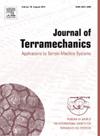In-house instrument development and updated classical equations for compacted snow characterization
IF 3.7
3区 工程技术
Q3 ENGINEERING, ENVIRONMENTAL
引用次数: 0
Abstract
Testing and evaluation of commercial passenger car and truck tires for severe snow usage are performed on compacted snow tracks based on the ASTM F1805-20 standard. The snow track is characterized for these tests using the CTI penetrometer. Evaluating the compactness of the snow track as an index number is helpful, but it does not provide information that can be useful from a simulation/modeling perspective.
In this work, a new device was developed that was inspired by the ‘Russian snow penetrometer’ to help evaluate the compressive and shear properties of snow. It was found that the classical methods of analysis used for Rammsonde penetrometers and Clegg hammers had some discrepancies that partially stem from assumptions made in their formulations. This work proposes modifications to the equations thereby improving their outputs to align with a more physics-oriented approach. The assumptions in the formation of classical equations are not incorrect but may not be completely accurate for cones with a higher surface area to base area ratio.
Future work could be assessing the accuracy of the devised equations in different terrain conditions and a sensitivity study to identify critical cone angles in different conditions.
内部仪器的发展和更新的经典方程压实雪表征
根据ASTM F1805-20标准,商用乘用车和卡车轮胎在压实的雪地轨道上进行了严重积雪使用的测试和评估。在这些测试中使用CTI穿透计表征雪迹。将雪道的密实度作为索引值进行评估是有帮助的,但它不能提供从模拟/建模角度来看有用的信息。在这项工作中,受“俄罗斯雪穿透仪”的启发,开发了一种新设备,以帮助评估雪的压缩和剪切特性。人们发现,用于雷蒙德穿透仪和克莱格锤的经典分析方法存在一些差异,部分原因在于它们的公式中所做的假设。这项工作提出了对方程的修改,从而改善了它们的输出,使其与更面向物理的方法保持一致。经典方程形成中的假设并非不正确,但对于具有较高表面积与基面积比的锥体可能不完全准确。未来的工作可能是评估设计方程在不同地形条件下的准确性,以及在不同条件下识别临界锥角的敏感性研究。
本文章由计算机程序翻译,如有差异,请以英文原文为准。
求助全文
约1分钟内获得全文
求助全文
来源期刊

Journal of Terramechanics
工程技术-工程:环境
CiteScore
5.90
自引率
8.30%
发文量
33
审稿时长
15.3 weeks
期刊介绍:
The Journal of Terramechanics is primarily devoted to scientific articles concerned with research, design, and equipment utilization in the field of terramechanics.
The Journal of Terramechanics is the leading international journal serving the multidisciplinary global off-road vehicle and soil working machinery industries, and related user community, governmental agencies and universities.
The Journal of Terramechanics provides a forum for those involved in research, development, design, innovation, testing, application and utilization of off-road vehicles and soil working machinery, and their sub-systems and components. The Journal presents a cross-section of technical papers, reviews, comments and discussions, and serves as a medium for recording recent progress in the field.
 求助内容:
求助内容: 应助结果提醒方式:
应助结果提醒方式:


